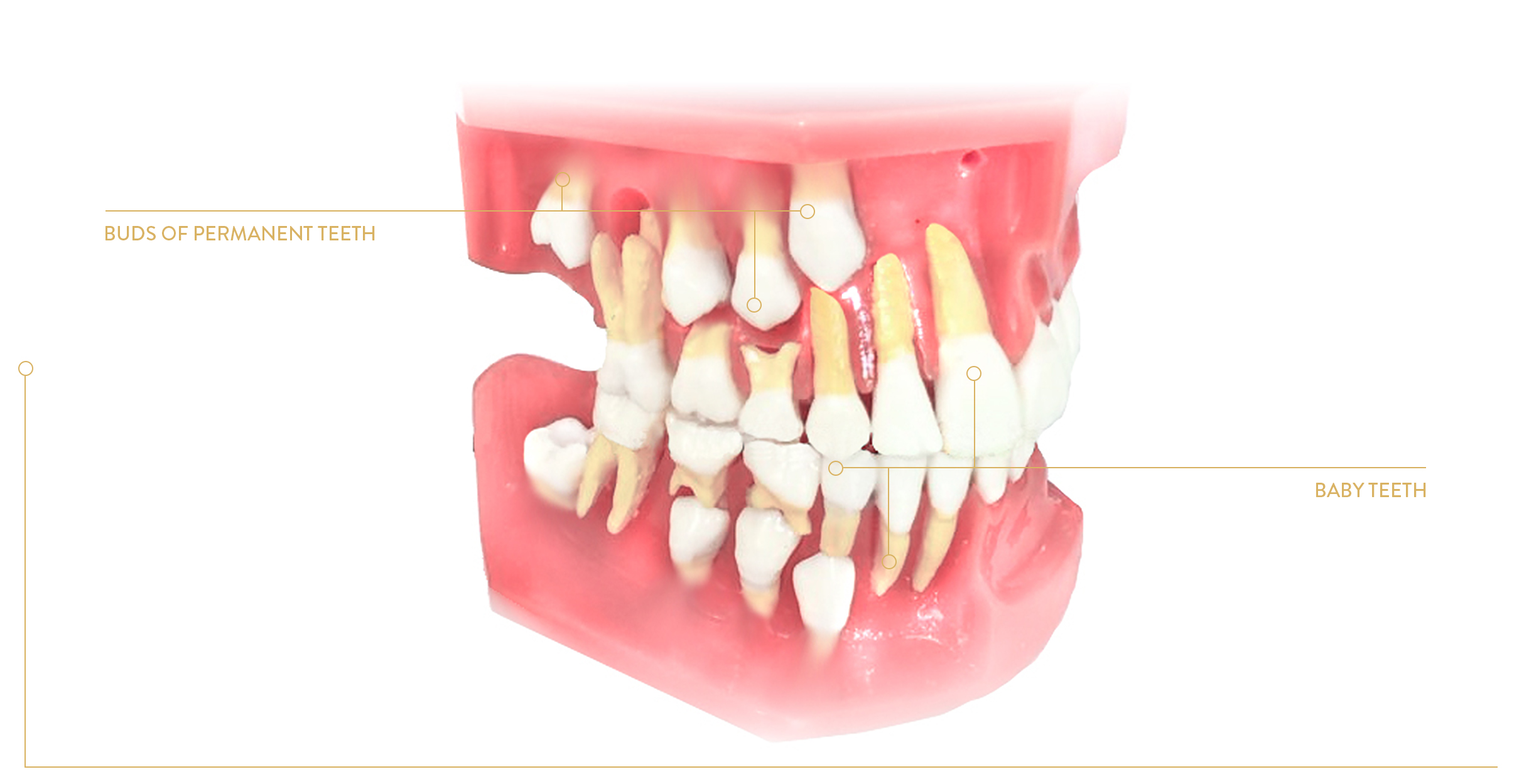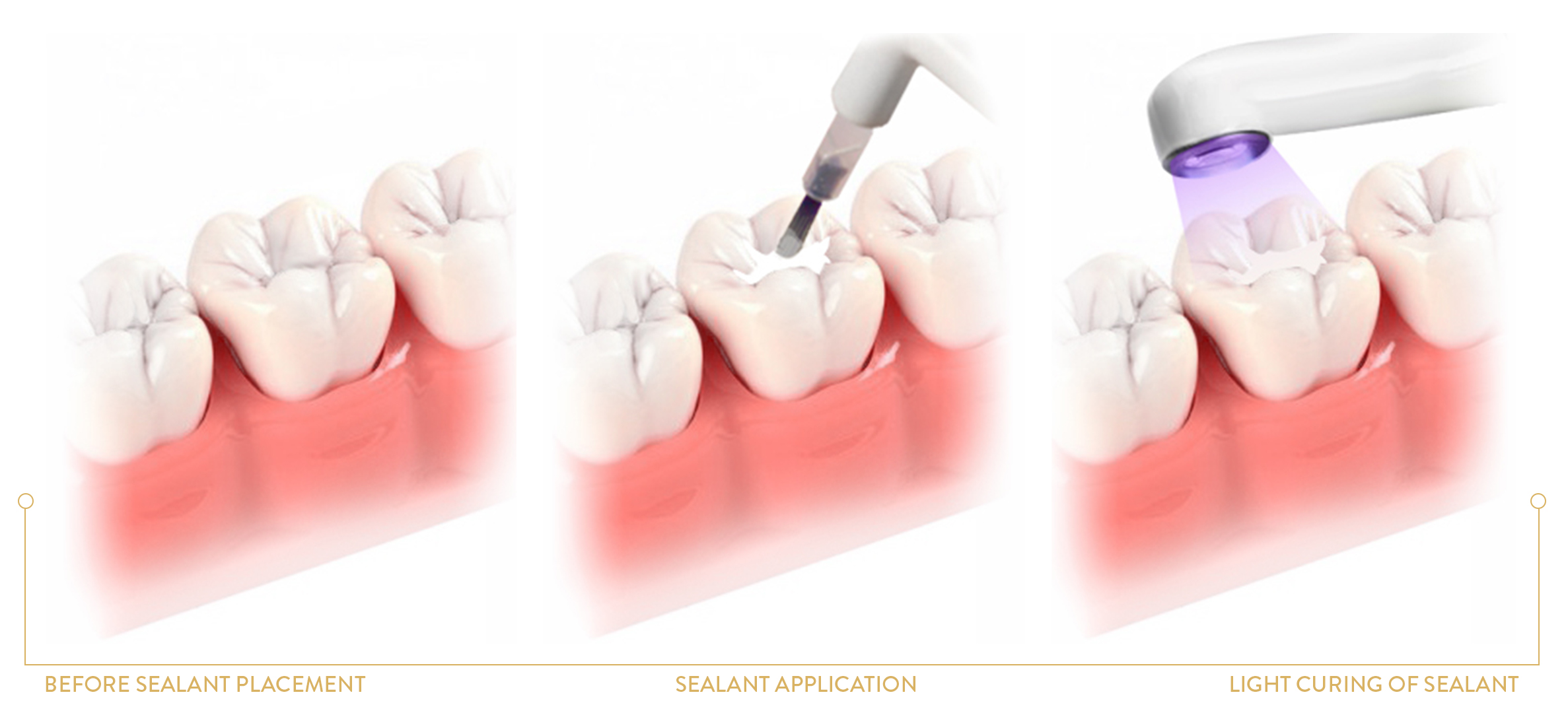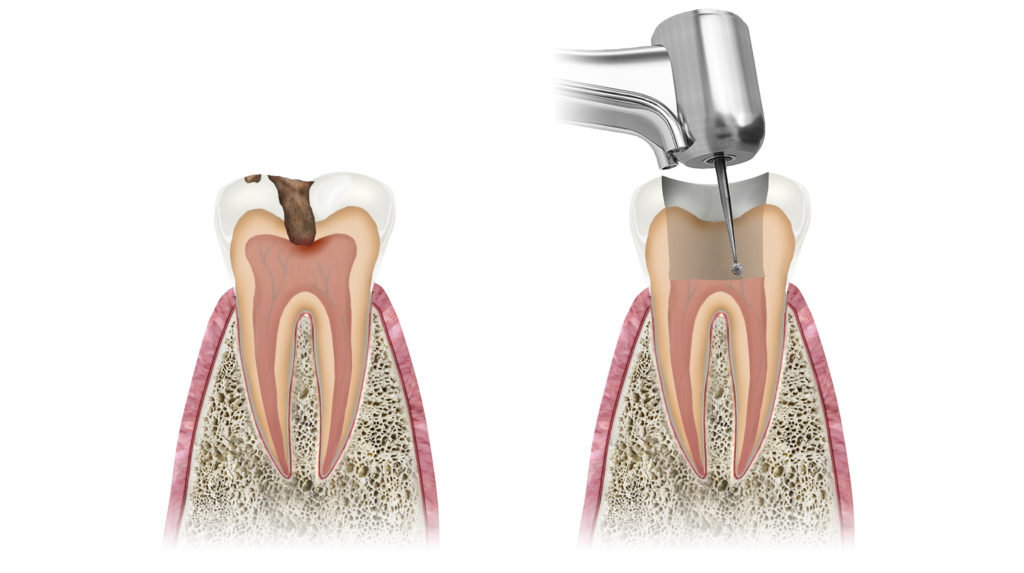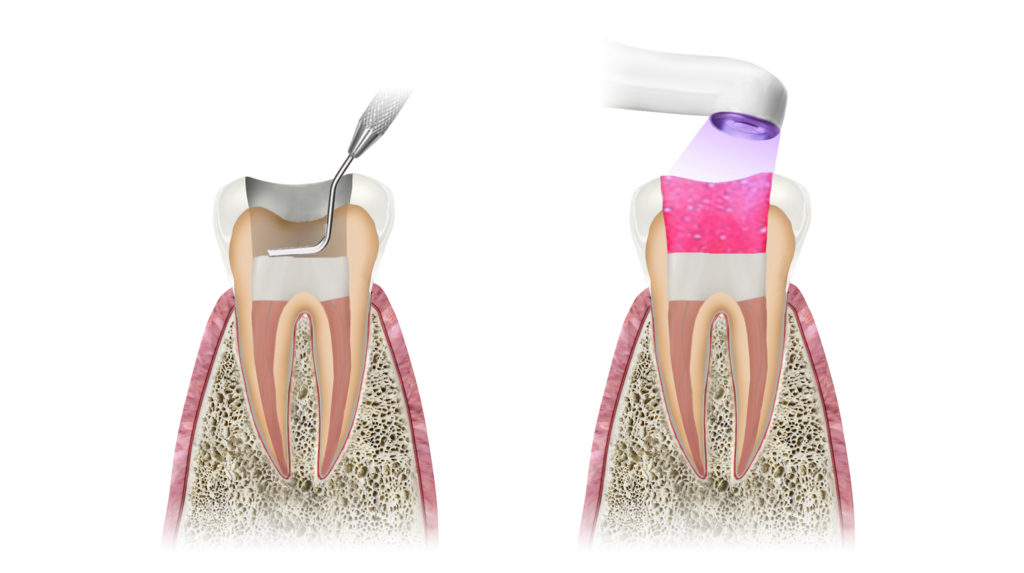What does paediatric dentistry do?

MODEL OF PERMANENT TEETH BUDS IN THE CHILD’S SKULL
A child’s adventure with dentistry should start with an adaptation visit, during which the doctor dedicates time to talk to the child and to familiarise them with the practice. Young patients are often afraid of the dentist, so it is important that their first contact is stress free and takes place in a pleasant atmosphere. Children that are protected from pain and negative associations will acquire good habits in the future, and visits to the dental practice will be a natural and permanent element of their health care. Healthy smiles on the faces of children mean healthy smiles on the faces of adults.
During the first few visits, children and parents learn the basics of oral hygiene and are provided with health-related dietary recommendations. Check-up visits should take place every 3-6 months, depending on the risk of caries, which is assessed by the dentist. At the end of each visit, the young patient receives a prize for courage, which is an incentive to return for further meetings.
Objectives of paediatric dentistry:
- promoting oral health among children, adolescents and their parents (dietary tips and hygiene instructions)
- monitoring the development of the masticatory system
- professional methods of caries prevention: tooth cleaning, fluoride prophylaxis, pit and fissure sealing
- diagnostics and treatment of pathological developments – carious disease, post-traumatic damage to milk teeth and permanent teeth, developmental defects, orthodontic prophylaxis, removal of milk teeth
Milk teeth
During human life, we can list three periods of dentition: milk, mixed and permanent. We are born with buds of milk (also known as primary, deciduous or temporary) teeth and permanent teeth, and although the milk teeth are the first to appear in the mouth, they have contact with the buds of permanent teeth, which develop in the bones of the jaws. There are 20 milk teeth. They appear in the mouth about 6 months after a child is born. They resemble permanent teeth, but they are much smaller, whiter and weaker.

periods when milk teeth erupt and shed
Caries in milk teeth is not just an aesthetic problem, but also a threat to the permanent teeth that are developing just under the roots. Caring for their health is an investment for life.
Permanent teeth
Permanent teeth buds are formed in foetus and develop in the child’s maxilla and mandible until eruption, which begins around the age of 6. An adult person usually has from 28 to 32 permanent teeth (depending on the presence of wisdom teeth). Replacement of milk teeth with permanent teeth occurs as the milk teeth fall out and permanent teeth appears in their place, with the exception of the first molars, which do not replace any milk teeth and erupt behind the last milk molar. The appearance of the first molars often remains unnoticed by the child and parents.

periods when permanent teeth erupt and shed
Modern techniques of paediatric dental treatment
Paediatric dentistry, even more than other areas of dentistry, requires the right approach to the patient. Considering the importance of the first visits of the child to the dental practice and what a huge impact they have on the further treatment process, it is important that everything is stress-free, safe and painless. Modern technologies for the treatment of milk teeth enable complete elimination of pain and limit invasiveness.
Prevention
Adaptation visit
Adaptation visit – the child meets the dentist and the dental practice environment. The whole visit takes place in a friendly atmosphere, in the form of play.
Placement of dental sealants
Placement of dental sealants on tooth pits and fissures involves applying a special preparation (sealing wax) to the natural cavities appearing on the tooth surface. This seal provides protection against plaque retention in areas that are difficult to clean. Sealing is a procedure performed on recently erupted permanent side teeth whose surface has not been affected by caries. It is also possible to seal the lateral surfaces of healthy milk teeth.

dental sealant placement
Fluoride varnish treatment
Contact fluoride varnish treatment involves treating all tooth surfaces with preparations containing fluoride compounds. About 48 hours after the procedure, the varnish is exfoliated, and the fluoride it contains is embedded in the tissues of the teeth. This treatment strengthens enamel and reduces its susceptibility to decay. Varnishes are recommended for use on both milk and permanent teeth.
Treatment of milk teeth
Anaesthesia and inhalation sedation
Inhalation sedation treatment with a mixture of oxygen and nitrous oxide (so-called laughing gas) relaxes and calms the child and suppresses any fear they might have while maintaining consciousness. Laughing gas also has a slight anaesthetic effect, which additionally affects the comfort of treatment for the little patient. The gas can sometimes carry the patient to the land of dreams, a pleasant experience for the child, that leaves unforgettable memories. More about inhalation sedation, here.
The Wand system is a painless, computer anaesthetic, which helps avoid any fear of needles by using a non-syringe system to apply a safe dose of anaesthetic.
Conservative treatment
When treating children’s milk teeth, coloured fillings are often used. A child dentist (paedodontist), after explaining to the child the method of treatment and the possible use of anaesthesia, cleanses the tooth of decay, just like with any other kind of filling. After preparing the tooth, the doctor dries it and puts in a coloured filling, chosen by the child. The final stage is to harden the filling with a special lamp and polishing.

encouraging colourful fillings for children
Treating permanent teeth in children is no different to treating permanent teeth in adults. More information about conservative dentistry is available here.
Pulpotomy and canal treatment of milk teeth
Deep defects reaching the pulp of the tooth can inflame it. In such circumstances, the preferred treatment is pulpotomy or root canal treatment.
Pulpotomy treatment of milk teeth involves removing the infected part of the pulp (pulp chamber), while leaving the healthy pulp in the tooth canal. During the treatment, antiseptic preparations are applied to reduce the risk of recurrent tissue infection.

1. tooth with advAnced decay 2. removal of affected pulp from chamber
3. APPLICATION OF COMPRESS TO THE PULP CHAMBER 4. COLLORFULL FILLING
pulpotomy
Root canal treatment of milk teeth is performed when pulpotomy treatment is no longer possible, since the pulp of the tooth is completely infected (both chamber and canals). In this case, it is necessary to remove all the diseased tissue and fill the canals. Since the roots of milk teeth ‘dissolve’ prior to the eruption of a permanent tooth this treatment can only be performed in a limited time period. Root canal treatment in the anterior teeth can be considered in patients up to 4-5 years old, and other teeth up to 7. This procedure is performed only in cooperating patients.
After pulpotomy or root canal treatment, the tooth should be rebuilt using a filling.
Celluloid and steel crowns
In cases of significant damage to the crown of the milk tooth, it is possible to rebuild its tissues using celluloid or stainless steel crowns. Thanks to this, the child regains not only the tooth function, but also its aesthetic appearance.

examples of paediatric crowns
Celluloid crowns facilitate reconstruction with a composite material in the anterior milk teeth.

reconstruction of damaged milk teeth using celluloid crowns
Stainless steel crowns are used for reconstruction and protection of damaged milk teeth in the lateral section.

using steel crowns on a child
Frequently asked questions
What should I do in case of a tooth injury?
In the case of a broken or knocked out tooth, you should find the broken fragment or whole tooth and place it in a container with physiological saline or milk as soon as possible or put it in the mouth and immediately go to the dentist.
At what age should a child have their first appointment at the dental practice?
Milk teeth appear early in a baby’s mouth, so even before its first birthday, it is worth visiting a dentist who will check if the teeth are erupting properly. The doctor will also assess the condition of the gums and the oral mucosa. During the visit, parents will also learn how to properly care for the child’s teeth.
Is it worth using coloured filling?
Of course. Coloured fillings are an additional incentive for children to brush their teeth, and they also release a large number of fluoride and zinc ions, with bacteriostatic and anti-caries properties. Fillings are clearly visible, so the parent can immediately notice if they are missing and visit the dentist with the child.
How should a child be prepared to visit the dentist?
First of all, do not raise fear in your child. You should explain to them what the dentist does and why they are visiting them. It is worth warning the child that during treatment they may feel slight discomfort. It is important that the child knows that a visit is necessary if they want to enjoy healthy teeth and not feel pain in the future.
Is it worth treating milk teeth?
Yes, because how permanent teeth set depends on them. Milk teeth with carious developments are also a source of bacterial infections not only for the oral cavity, but for the whole body of the child. Under no circumstances should they be neglected.
The idea that milk teeth should not be treated because they will fall out anyway is false and very harmful to the proper development of early dentition. Good oral hygiene from an early age protects against dental caries and other oral diseases.
Untreated cavities in milk teeth may result in bacterial infections and malocclusion, leading to the need to begin orthodontic treatment.
For what purpose is fluoride treatment applied?
Fluoride strengthens teeth and makes them immune to damage from acids and simple sugars. In addition, it remineralises enamel, reduces the possibility of tooth decay and prevents it from developing.
Why shouldn’t under-16s whiten their teeth?
Since the process of tooth mineralisation continues until age 16, whitening is not recommended beforehand.









